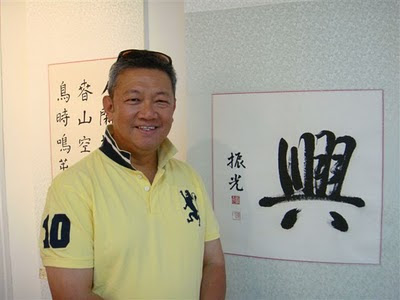今天,陈振光,一个受英文教育者,与我们分享他学习书法的历程与决心。
华人说,‘活到老,学到老’。在今天的社会,为了能跟得上社会的不断改变,不断与快速地学习是很重要的。我在读中小学时,新加坡的学校分为华校与英校。我们必须选读一科第二语文才能毕业。我当时读的是英校,而华文就是我的第二语文。在我们那个时候,华文科所学的东西相当基本,不外是口试与作文。每一次的班上考试,听写或默写,对我来说都是一种挣扎。这些学习其实都只是死记措词及苦练写法。字的笔画并不重要,只要字形在纸上看起来有点象,句子通顺就可以了。我对中国古典文学与历史所知不多,虽然我愿多学些成语,写作文时就可以多得些分数了。那时完全没用过毛笔。而书法对我来说是属于一部分华人高级知识分子的东西。我经历过了这样的教育系统。现在,这些都成为历史了。
对我而言,以华语交谈与阅读繁体字一般没有问题,而日子就这样一天天过去。在我的工作环境里,华文并不常用。一年过一年,过去所学的,都已经还给华文老师了。随着日子的过去, 需要与中国做生意,因为无人能忽视这个大而快速增长的经济体。这就给我麻烦了。如果我能说流利的华语,再加上能够阅读华文,在华人生意环境里,就能处于有利的位置。可是以前所学根本就不足够。中国丰富而长远的历史,远远多过我以前所学;而中国文学、古典经文、诗词、文字以及其他的东西,对我而言,形同外星人。
不去埋怨过去,我尝试寻找机会来读与写华文。每个周末,我会将本地主要的中文报 -- 联合早报和每天都读的英文海峡时报一齐读。为了加强华文学习,也观看华语古典电影,如‘三国演义’、‘水浒传’、‘康熙王朝’、‘大宅门’。我也很轻松地从这些连续剧得到中国一些历史与其他方面的知识。
智者言‘移公移山’是指‘信念可以移动山丘,没有信念,不存的山丘就也存在’。亦言:‘千里之行,始于足下。’这些含有积极与鼓舞意义的成语都是我想与大家分享的 ,有利于我们应用于日常生活之中。我鼓起勇气参加了书协的三年书法与文学课程。在这三年间,我庆幸能从我的师长、学长 、同学中学习。以后,我将继续与各位分享我的学习过程中的甘与苦。
最后,我要说的是‘我能,你当然也能!’每一位受英文教育者,只要他有意志力,学习华文与书法是没有障碍的。
资料来源:http://icalligraphy.blogspot.sg/2010/10/johnson-tan-chin-kwang-on-learning.html
资料来源:http://icalligraphy.blogspot.sg/2010/10/johnson-tan-chin-kwang-on-learning.html
 |
| 陈振光与他的书法 Johnson and his calligraphy |
Today, Johnson Tan, an English educated, shares with us his determination and experiences in learning Chinese calligraphy.
As the Chinese saying goes ‘live and learn’, continuous learning is so important in today’s fast changing world that one must learn fast to catch up with the pace. In my days of primary and secondary education, the schools in Singapore were divided into English stream or Chinese stream. All students needed to study a second language in order to complete their studies. For me, I studied in an English school and Chinese was my second language subject. Chinese studies during my time were very basic and it was more a language consisted of oral practice and composition writing. It was always a struggle for me when it came to class test, examination on dictation or write from memory. We needed to memorize all the wordings and writings by heart. How strokes were written was not considered to be important as long as the words look recognisable on paper and the phrasing is proper. I learned very little about Chinese classical literature or history, although I memorised some idioms that could be used in composition in order to get extra marks. No Chinese brush was used then and Calligraphy to me was just something for a small elite group of Chinese educated scholars. I survived through this education system. And it is history now.
For me, conversational Chinese and reading the classic/complicated font are quite manageable and life goes on. Writing in Chinese is generally not common in my working environment and as years passed by I have returned what I have learned to my Chinese teachers.
And then there is a need to do business with China, as most businesses today cannot miss the opportunity created by this big and fast growing economy. However, this is becoming a challenge for me. If I can speak fluently in Mandarin and am able to read Chinese, I can position myself well within the China business circle. But, the fact is that what I learned in school is not good enough. The rich and long history of China is much more than what I had learned before and the Chinese literature, classics, poems, writing and many more are just alien to me.
With no regrets for the past, I try to find opportunities to read and write in Chinese. Now my weekends mean having to read the Singapore main Chinese newspaper Zaobao together with my daily Straits Times. In order to brush up my Chinese, I also watch Chinese classic serial movies like the ‘The Romance of the Three Kingdoms’, ‘Water Margin’, ‘Kangxi Dynasty’, ‘The Grand Mansion’. These are just some very good serial movies that conveniently provide me with some facts on Chinese history and other Chinese knowledge.
A Chinese folktale talks about ‘The old man moves a mountain’, which is actually about how ‘Faith can move mountain and without Faith, non-existing mountain will just be created’. There is also a saying that ‘A journey of a thousand miles begins with the first step’. All these encouraging and positive idioms are very useful and applicable in our lifestyle that I would like to share with you. I take the courage and determination to enrol in a 3-year learning course on Chinese Calligraphy and literature at the CCSS. During the 3 year period, I had the privilege to learn from my teachers, my seniors and peers. There are many pains and gains through this learning process which I can share with you in future.
To end this note, I must say that ‘If I can make it, you can make it too’, as there should be no hurdles or obstacles for an English educated person to learn Chinese writing or Calligraphy if he or she has the will power.
Source: http://icalligraphy.blogspot.sg/2010/10/johnson-tan-chin-kwang-on-learning.html
Source: http://icalligraphy.blogspot.sg/2010/10/johnson-tan-chin-kwang-on-learning.html
No comments:
Post a Comment